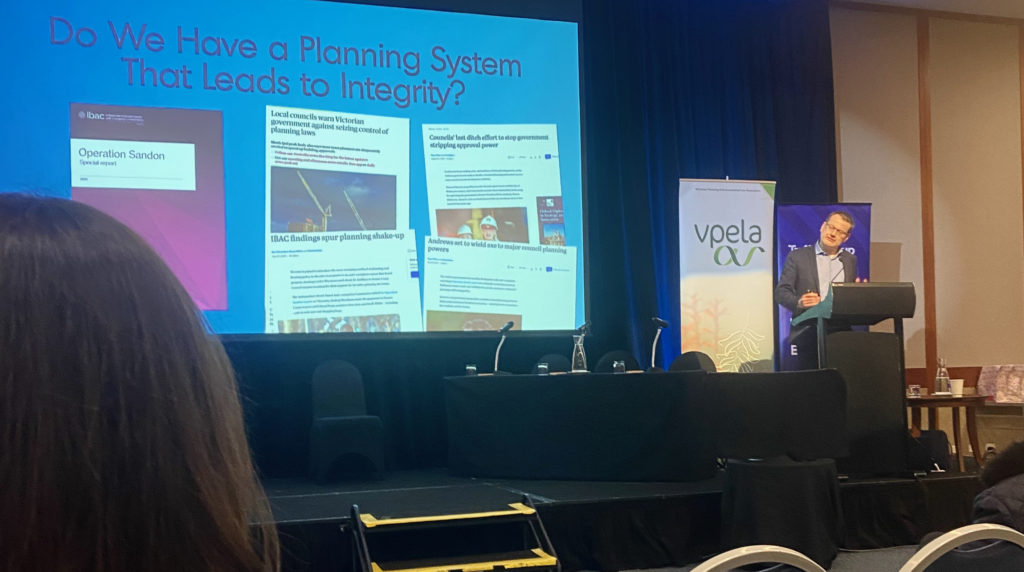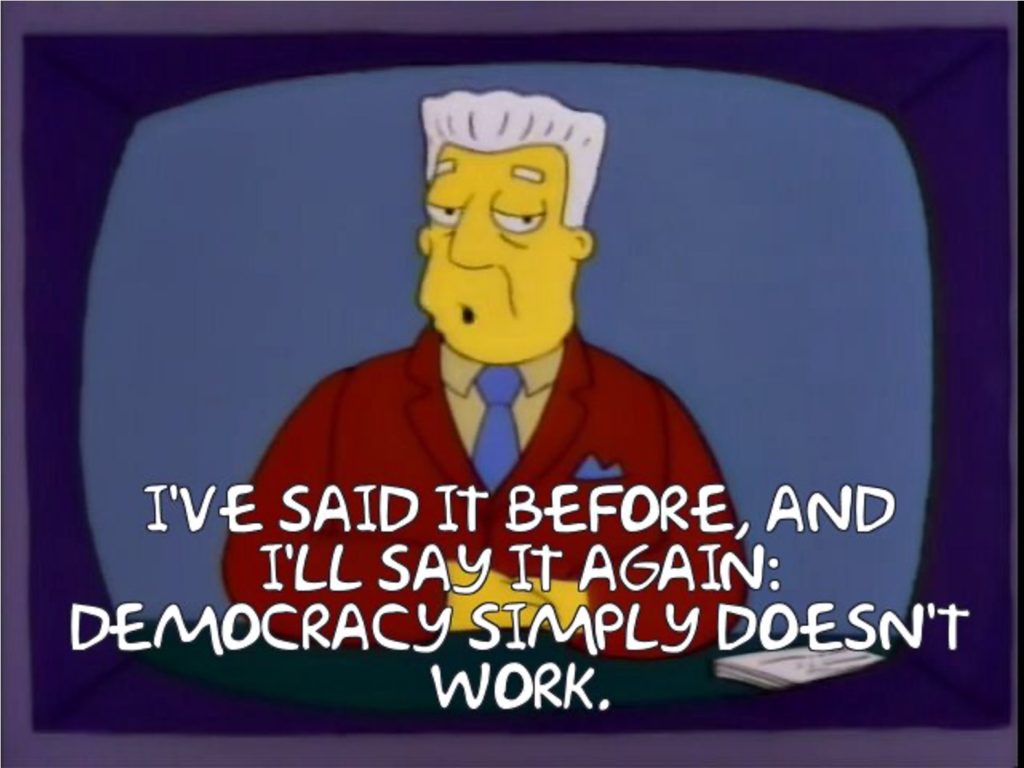
The Operation Sandon Special Report, released in July by the Independent Broad-Based Anti-Corruption Commission, is vital reading for all Victorian planners and allied professionals. This is not so much for its findings about the matters at Casey that prompted the investigation, but instead for its timely centring of the issue of integrity in the discussion of planning system reform.
Planning system reform is frequently framed primarily through a lens of red-tape reduction that sees increased system efficiency as its primary goal. However more balanced system reviews have also recognised that it is vital to maintain system effectiveness – after all, no level of regulatory burden is warranted if the planning system is not achieving the policy outcomes it is there to achieve.
However the Sandon report is an important reminder of the third key pillar of any balanced system reform package: transparency and integrity. While some system reviews have commendably highlighted this as a key focus – notably 2003’s Better Decisions Faster and the 2017 review of the Victorian Planning system by the Auditor-General – too often this aspect of system design has passed unremarked.
This likely reflects a wider complacency about integrity issues with roots in the design of our system. Victoria’s extensive third-party notice and appeal rights, combined with the interplay through the decision-making process between council planning officers, elected councillors, VCAT, and (occasionally) the Minister, have done much to keep the planning system clean.
This has meant Victoria has until now not had the moment of truth that the NSW planning profession faced nearly 15 years ago following investigations into the Wollongong council. Writing about those findings in Planning News in 2011, The Hon Jerrold Cripps (then Commissioner of the NSW Independent Commission Against Corruption) highlighted key system design features that can create corruption risks: routinised exercise of discretion (where, for example, standards such as height limits were routinely varied, and where insufficient guidance existed about such variation); out-of-date planning instruments (which further encourage variations to planning standards); and lack of clear justification for decisions.
This list of system traits should, I think, prompt concern for Victorian planners. The architecture of the Victorian system – built on highly discretionary controls and frequently vague principle-based guidance – has fundamental vulnerabilities from an integrity perspective. If the Victorian system has indeed been kept (mostly) clean by third-party rights and interplay between different decision-makers, we should be alert to the implications of system reforms that wind back those rights or centralise decision-making.
The Sandon investigation’s focus was particularly upon the behaviour of councillors, and in response to the report Premier Daniel Andrews commented that it was the government’s view that “the role of local councils in significant planning decisions should be reduced.” This foreshadowed subsequent reforms that have diverted responsibility for various categories of significant proposal from councils to the Minister.
Yet the Sandon report offers no basis for preferring Ministerial decision-making over that of councils. It notes (at pages 184 and 185) that “the corruption risk that applies to a councillor may also apply to a minister” and that the corruption risks of elected officials undertaking decision-making “[cannot] be resolved by transferring responsibility from elected councillors to a minister.” The report goes on to note various examples of dubious Ministerial decisions. This echoes the Auditor-General’s report of 2017, which was highly critical of the governance and transparency surrounding Ministerial decision-making.
Neither the Sandon report, nor integrity concerns more generally, should be used to justify shifting powers from councils to the Minister.
What Sandon did recommend, however, is shifting planning permit decisions from elected councillors to independent decision-making panels – a model used, with some variations, in NSW, South Australia, and Western Australia. The report insists that such a change would not be anti-democratic, arguing that “the Planning Act makes clear that the planning permit process is an administrative process of evaluating a proposal against the relevant criteria.”

An obvious rebuttal is that under the Act permit decision-making has in fact generally been vested with political decision-makers, with unelected decision-makers taking over only on appeal or when elected decision-makers choose to delegate their power. Nonetheless, this model is attractive at a theoretical level. It can be analogised to models of branches of government: in this model, plan-making is seen as a democratic / legislative function, and the business of making decisions against that plan is an administrative / executive function requiring only limited further democratic input.
This leads to my only criticism of what is otherwise an excellent report, which is that this conception of the role of democracy in decision-making sits uneasily alongside its own observations about how policy is written in the Victorian system. Echoing previous reviews of the Victorian system, the report notes that the way policy is framed in Victoria creates a “broad scope of plausibly ‘correct’ decisions.”
This creates an integrity challenge. As the Sandon report puts it:
The scope for disagreement on the same facts poses a problem for oversight; it is harder to identify self-interested or corrupt decision-making if such decisions can be easily said to satisfy plausible planning motives and cannot readily be discerned from good-faith decision-making.
I would add, however, that the lack of policy resolution also complicates the report’s suggestion that permit decision-making is a purely administrative role. If policy remains unresolved at the strategic level we cannot blithely dismiss the role of democratic engagement at the planning permit stage.
The issue of policy resolution returns us to the importance of centring integrity and transparency issues in discussions of system design. If we conceive of integrity risks as flowing from obvious ethical transgressions such as bribery or undeclared conflicts of interest, then the solutions are conceptually straightforward. It is for these actions that checks and balances such as review rights and appeal bodies provide clearest value.
It is not that simple, however. There are many shades of grey between the extremes of a conceptually ideal decision (made in the public interest, well reasoned, and not subject to any conflicts) and a corrupt decision. These include not just more ambiguous or marginal forms of conflict of interest, but also a dizzying array of factors that can undermine the rigour of decision-making: ideological preconceptions and biases; poor or boilerplate explanations; selective or purposive reading of the scheme; lack of attention to the replicability of decisions; substitution of heuristics for bespoke assessment; and so on.
Individual decision-makers – and others who should be assessing matters as a decision-maker would, such as expert witnesses – are also subject to countless subtle pressures that can drag them away from ideal decision-making. These most prominently include time pressures and (for expert witnesses) the insidious financial pressure to justify proposals for those who hire them.
This is partly a challenge for individual planning professionals. We should not conceive of integrity as defined by a clear ethical “cliff” over which we can fall into corrupt behaviour. Rather, we each stand on the top of a dome, with no clear line between us and the slide off the edge into poor or improper decisions. Our responsibility as planning professionals is to continually audit or own decision-making and professional practice to keep ourselves centred on the top of that dome.
The planning system should help us in those efforts by, as much as possible, providing clarity about the edges of acceptable decision-making. The Sandon findings about the broad scope of plausibly correct decisions are reminder that, too often, the Victorian system fosters a lack of clarity that leaves too much scope for garden-variety poor decision-making that can then blur into, and help conceal, genuinely improper decisions.
Crucially, improvements in this regard can help improve all aspects of system design. When considering system reforms in terms of the pillars of efficiency, effectiveness, and transparency / integrity, it is often the case that these imperatives are in tension. Third-party appeal rights, for example, have an efficiency cost for a transparency / integrity dividend (and, I would argue, an effectiveness bonus as well through improved outcomes). An efficiency-focussed reform that winds these back is therefore likely to have an effectiveness and integrity cost. This may be justified, but the trade-off should be weighed carefully. Improving the clarity of schemes, however, has the potential to improve efficiency, effectiveness and transparency simultaneously.
The opportunity for genuine system improvement will be missed, however, if there is not a rigorous and careful response to the Sandon report. Previous system reviews (such as the 2017 Auditor-General report) were allowed to pass without this occurring. Instead, these reviews were swept aside as reform packages were released that did not properly align with those findings. This allowed problems to fester and has contributed to the current difficulties with the planning system. It is vital that this not be allowed to occur with the Sandon findings.
This article was first published in the October 2023 VPELA Revue and is based on my keynote address at the 2023 VPELA conference.